
Light on the Dark Side: Images
and Reflections from Outer Space
- Phil MacGregor
_______________________________
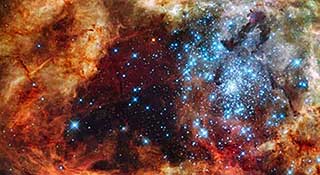
Fig. 9. Enigmatic shot of cloudy matter, 2009 
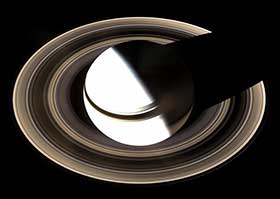
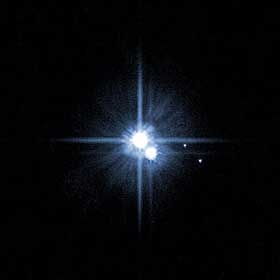
Fig. 11. The Moons of Pluto, 2005 
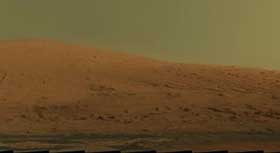
Figs 12a and b. Mars’ mount Sharp, 2014 
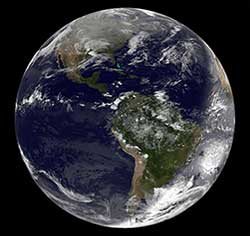
There is even some primitive comfort, rather than terror, in the fact that space is shown to have form at all, that there is order, albeit barely recognizable even when translated from the invisible spectrum into optical objects. This is where the sublime argument may be stretched, because unlike witnessing a storm at sea, where the observer is physically at risk, with few exceptions the space imagery by definition is spectacularly remote.
The sense of order brings into question the role of information. To abstract the qualities that add to appreciation of the images, it is worth considering the role of knowledge provided by text about the pictures because few of these abstract depictions are truly denotative — they are not in Barthes' terms, a message without a code. The explanation of what they are can be extraordinary and one that challenges intuitive understanding. It is crucial to their cultural impact and value that they do represent physical phenomena, however convoluted the process of representation may have become through technologies of image processing, false colour and enhancement. Fact and context form essential parts of the interpretation. This enigmatic example in a different context might be taken to be a close-up shot of an intestine (fig. 9). It is a study of the Magellanic Cloud.
The scientist-artists provide composite assemblies to conform to our classifications, such as the idea of galaxy, dust cloud, or at a more basic level, objects like asteroids, or processes like “jets” and “bubbles” or “mountains.” They bring a message, crudely speaking, of truth and evidence that forms an integral part of image appreciation.
So much for the much reproduced class of blurry, mysterious images [17] found on the websites, whose forms are suggestive to the imagination, hovering between form and chaos, and between solidity and nothingness. A second species of artistic imagery of space, with a long history in astronomical writings and visualisation, concerns images that are sharply defined, and precisely geometrical, like the planet Saturn taken by the spacecraft Cassini (fig. 10).
The wonder that they elicit seems connected to a different aesthetic that is linked to perfection and perfect form. They do fall under the generic term of beautiful — but appeal to a faculty of idealization. This aesthetic is classical, the one that began with the fascination in the Renaissance period with geometry and three-dimensionality. The style of imagery does not have the same novelty value as the Hubble-style products because the geometrical aspects of heavenly bodies have been visualised since the development of telescopes. What recent space imaging has achieved is an impressive expansion in the quality of the visions, and range of objects and shapes to be depicted (fig. 11). The effect is both warm and chilling. There is comfort in the realization that regularity and even “beauty” are woven into the fabric of spacetime. The view may provide only cold comfort, but the vision is anything but chaotic or, you might argue, alienating. They are familiar earthly geometries transposed into the sky. They connect with the positive enlightenment views of the mechanical regularity of nature, the world of the poet Alexander Pope, and thus to an aesthetic which is still very much alive in popular photography. Such photos are not sublime: they can be fully comprehended.
So much then for the most aesthetic of the space images, those that the websites seem to include primarily for their so called beauty, many of them consciously constructed by NASA artists with that goal in mind.
The Various Forms of Space Imagery on Websites
Not all doctoring is for one purpose. For example, much less “beautiful” shots of spacescapes are photoshopped for wide public consumption. The rather dull “mountain” visible near Curiosity's landing site on Mars was given an artificially blue sky, like earth, when the real sky colour on Mars is more orange and yellow (figs 12a and b).
Yet another provocative set of space pictures that have potent imaginative ring for the public are the direct shots of earth from satellites or space stations (fig. 13). These shots of earth can excite expressions of wonder and humility especially when combined with some social event like “Christmas Day” in the headline. On the Cosmic Log site, one admirer commented:
What a simply gorgeous view of our stunning planet. Though we have come so far in many areas of science and knowledge, we are no wiser in the ones that matter most, learning to be more compassionate and peace-loving.
Thoughts of one shared planet, fragility, and of a united human destiny are commonly associated with the backward view from satellite towards earth. The sense of awesomeness is undeniably present, but it is not sublime. In these shots, aesthetics meet ideologies and create suggestive associations of thought and feeling often centred on conservation. As Zoltan Levay told Elizabeth Kessler, his hope in editing the shots was that they would engender a new regard for the terrestrial world. A similar ideological framework is discussed by Parks [18], in relation to the Digital Earth Project, a U.S.-funded initiative to make space imagery available to the public. She suggests the project transfers space imagery from military hands to civilians and moves the Earth-from-space images into a realm of civic engagement, but in her opinion the whole earth vision is falsely sanitized and given a saccharine tone of supra-world tourism.
Indeed, the metaphors of the tourist and tourism can be extended to interpret several categories of space image-making, not just ‘earth-from-space' photographs. The whole construct of “natural beauty” aside from the sublime, has a long critical history. A recent discussion is given in the aesthetic criticisms of Adorno [19]. Deploring the bourgeois narcissism of the temperament that appreciates nature, Adorno (Ibid.) asserts the art world misrepresents nature as being “tamed,” because raw nature, if truly encountered in a non-sanitized version, would depict:
Mountains of debris from which the socially lauded aesthetic need for nature flees. Just how industrial it looks in outer space will someday be clear (p. 68).
In literal terms it didn't turn out so industrial as he expected. The visualization industry has never depicted space as comprising dereliction of any kind or an insult to the eye, but his argument would be that the exchange relationship has poisoned reactions to unmediated nature, and in this case the whole aesthetic armoury of spacescapes. As he says, the unmediated experience of nature has been subsumed to the exchange relation represented in the phrase tourist industry. “The essence of the experience of nature is deformed” (p. 69) so that even to appreciate natural silence has become a rare privilege to be commercially exploited.
[17] See the gallery on The Guardian's internet site.
[18] Lisa Parks, “Satellite and Cyber Visualities,” in The Visual Culture Reader (2nd ed) Nicholas Mirzoeff (ed) London, Routledge, 2002, pp. 279-291.
[19] Theodor Adorno, Aesthetic Theory, Minneapolis, University of Minnesota Press, 1998.


